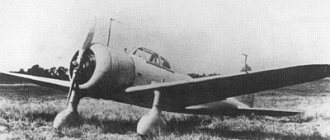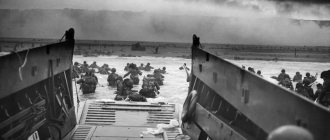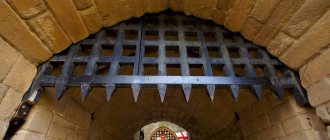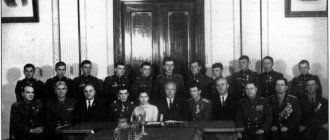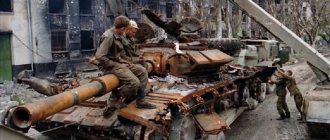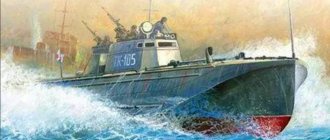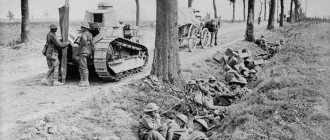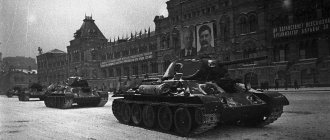On May 11, 1939, one of the largest military conflicts involving the Soviet Union began
The battles at Khalkhin Gol are considered the largest military conflict involving the USSR in the Far East since the Civil War and one of the largest military operations after the repression of command personnel in the Red Army. For many direct participants in these battles, the experience gained in the summer of 1939 turned out to be invaluable: it was this that allowed them to feel more confident at the front at the beginning of the Great Patriotic War than many other military leaders. For our country as a whole, this armed conflict played a colossal role and forced Japan to abandon the attack on the Soviet Union. But hardly anyone thought about all this at the very beginning of the events - May 11, 1939 - the day that is considered to be the starting point of the conflict.
Commander of the 1st Army Group of Soviet Forces in the Mongolian People's Republic, Corporal G. Zhukov, with a Japanese 150-mm howitzer Type 96, captured during the battles at Khalkhin Gol
Official Soviet version
The Japanese military, with militaristic views, unceremoniously and in violation of all treaties tried to break through the defense line, seize the Mongolian People's Republic and reach the Trans-Siberian Railway, threatening the entire Far East.
The problem is that there were no regular Japanese troops on the border with Mongolia; they were involved in a war with China. In the area of the Khalkhin Gol River there was a guard battalion of railway troops, local self-defense forces and law enforcement. At the beginning of the conflict, there were less than 2,500 bayonets, 6 armored vehicles and 1 outdated light tank. During the conflict, the number reached 35,000 people. About 400 thousand military personnel served in the Trans-Baikal Military District.
But reconnaissance reported accurately And the Armored Shock Battalion went, swept up by the team, across its native land in the Far East.
Fighting at Khalkhin Gol in 1939
The Battle of Khalkhin Gol was a local armed conflict that lasted from spring to autumn 1939 near the Khalkhin Gol River in Mongolia (approximately 900 km east of Ulaanbaatar) in the steppe region of the Manchurian-Mongolian border. The roots of the conflict go back to 1927, when General of the Imperial Japanese Army, Prime Minister Tanaka Chiichi handed over to the Japanese Emperor a memorandum with clearly expressed plans: “ In order to conquer China, we should first conquer Manchuria and Mongolia. In order to conquer the world, we must first conquer China .”
Poor in natural resources, Japan in 1930 imported raw materials and exported finished products; the country needed controlled sources of raw materials and sales markets. Multimillion-dollar China was used as a market for finished products, and the Japanese leadership considered the USSR or Southeast Asia and the Pacific Islands as sources of raw materials.
In 1932, Japanese troops completed the occupation of Manchuria, and in the occupied territory they created a puppet government led by Pu-Yi in the state of Manchukuo, which was planned to be used as a springboard for further aggression against China, Mongolia and the USSR . The Japanese ambassador and commander of the Kwantung Army had more powers than the appointed king, Pu Yi.
In 1935, clashes between Mongolia and the Japanese Kwantung Army began on the Mongol-Manchurian border.
On March 12, 1936, the “Protocol on Mutual Assistance” was signed between the USSR and the Mongolian People’s Republic, and in 1937, the 57 Special Corps of the Red Army was deployed on the territory of Mongolia , commanded by division commanders I. S. Konev and N. V. Feklenko.
Map of military operations at Lake Khasan - from July 29 to August 11, 1938
In the summer of 1938, a two-week conflict occurred between Soviet and Japanese troops near Lake Khasan , which ended in victory for the USSR. The military conflict began with Japan's demands to recognize the Khalkhin Gol River as the border between Manchukuo and Mongolia, although in reality the border ran 20-25 km to the east.
The main reason for this requirement was the desire to secure the Halun-Arshan-Ganchzhur railway being built by the Japanese to the USSR border in the area of Irkutsk and Lake Baikal; in some places the distance from the railway to the USSR border was only two or three kilometers.
According to the Soviet historian M.V. Novikov, to substantiate their claims, Japanese cartographers fabricated false maps with the Khalkhin Gol border and “ordered to destroy a number of authoritative Japanese reference publications that contained a map of the correct border in the Khalkhin Gol River area.”
After the change in January 1939, tensions on the border increased. Japan began to put forward the slogan of expanding the Japanese empire “to Lake Baikal.” Attacks by Japanese troops on Mongolian border guards became more frequent, while Japan falsely accused Mongolia of deliberately violating the borders of Manchuria. On January 16, 1939, in the area of the Nomon-Khan-Burd-Obo height, a group of 5 Japanese soldiers fired at a detachment of four MPR border guards from a distance of about 500 meters.
January 17, 1939, at the height of Nomon-Khan-Burd-Obo, 13 Japanese soldiers attacked a detachment of three MPR border guards, capturing the head of the outpost and wounding another soldier. In February and March, the Japanese and Barguts carried out about 30 attacks on the MPR border guards.
By May 1939, the strength of the 57th Special Corps of the Red Army was 5,544 people, of which 523 were commanders and 996 junior commanders.
On May 11, 1939, confrontations began near the Khalkhin Gol River. Japanese-Manchu cavalry, numbering 300 people and 7 armored vehicles, attacked the border point and, after its defeat, reached the shore of Khalkhin Gol. Since May 14, border posts and army airfields in Mongolia have been attacked by Japanese aircraft.
The armed invasion was an integral part of Japanese plans to seize the Soviet Far East and Siberia, China and the possessions of Western countries in the Pacific Ocean. The Japanese military was preparing two options for waging war: northern - against the USSR and southern - against the USA, Great Britain and their allies.
Despite the warning from the Soviet government that the USSR would defend the Mongolian People's Republic (MPR) as its own territory, Japanese troops , having a threefold superiority in forces (about 40 thousand people, 130 tanks, more than 200 aircraft), crossed the Khalkhin River on July 2, 1939 -Goal and invaded the territory of the Mongolian People's Republic. After bloody fighting, the Japanese were forced to temporarily retreat. The Japanese were preparing to resume their army's offensive on August 24, but on August 20, Soviet troops launched a counteroffensive with the 1st Army Group under the command of corps commander Georgy Zhukov.
While inferior in number of troops, the 1st Army Group outnumbered the enemy by approximately twice the number of tanks and aircraft. The Mongolian troops were led by Marshal of the Mongolian People's Republic Kh. Choibalsan. Coordination of the actions of the Soviet and Mongolian troops was entrusted to the front group led by Army Commander 2nd Rank G. Stern.
The offensive of the Soviet-Mongolian army on August 20, 1939 was well prepared and was unexpected for the enemy. As a result of six days of fighting, the Japanese 6th Army was surrounded and virtually destroyed, losing more than 60 thousand people killed , wounded and captured, the losses of Soviet troops - 18 thousand killed and wounded . Soviet tank crews defeated and completely destroyed several Japanese divisions. The air battles were especially intense the largest at that time, in which up to 800 aircraft took part on both sides. As a result, the Japanese command asked for a cessation of hostilities, and on September 16, 1939 they were suspended.
The events at Khalkhin Gol had important international consequences. , received priority in Japanese plans . Soviet diplomacy, skillfully acting in the current situation, achieved the conclusion of a Neutrality Pact with Japan on mutually beneficial terms, which was signed in Moscow on April 13, 1941, which allowed our country to avoid a war on two fronts.
***
In 1939, a popular song by composers Dmitry and Daniil Pokrass based on the verses of the poet Boris Laskin, first heard in the film “Tractor Drivers”, directed by Ivan Aleksandrovich Pyryev. The film raised big themes: love, patriotism, honest and hard work. Throughout the film there was the idea of the need to be vigilant and ready for the upcoming battles with the enemies of the Motherland.
Clouds move gloomily over the border, The harsh edge is enveloped in silence. The Clock Homelands stand on the high banks of the Amur
There, a strong barrier has been put up for the enemy, There stands, brave and strong, At the borders of the Far Eastern land, the Armored Shock Battalion.
They live there - and the song is a guarantee of an unbreakable, strong family. Three tank crews - three cheerful friends. The crew of a combat vehicle.
Thick dew lay on the grass, and wide fogs floated in. That night the enemy flock to cross the border by the river.
But reconnaissance reported accurately: And the combat shock battalion went, swept up by the team, across the native land of the Far East.
Tanks rushed, raising the wind, Formidable armor was advancing. And the samurai flew to the ground, Under the pressure of steel and fire.
And they finished off - the song is a guarantee - All enemies in a fire attack Three tankers - three cheerful friends The crew of a combat vehicle!
The Mystery of the Countess de la Motte
The defense of the Osovets fortress is an “attack of the dead.”
Unofficial version
Soviet Russia needs a military conflict. It is important for Soviet Russia to show the European powers that it is an excellent ally. Soviet Russia needs arguments in negotiations with England and France (as already discussed in Potential Threats to the USSR 1939). A little mess at the edge of the universe is an excellent example of how backward communists fill an invincible rival with lead. A small conflict. For Japan, minor border disputes did not matter; they were far from the sphere of its interests.
And they finished off - the song is a guarantee - All enemies in a fire attack Three tankers - three cheerful friends The crew of a combat vehicle!
August: denouement
On August 4, the 6th Army was formed as part of the Kwantung Army - it included troops operating in the Khalkhin Gol area.
On August 7-8, Soviet troops launched a series of attacks, but the Japanese repulsed them. The command ordered to “dig in”, but Kamatsubara was going to attack on August 24 on the southern part of the bridgehead, so they did not build serious fortifications there.
The Soviet offensive was scheduled for August 20. Zhukov divided the troops into three parts, with the central one under his direct command. The northern and southern strike groups were to arrange “Cannes” for the Japanese.
The Red Army had a serious advantage, primarily in armored vehicles - 498 tanks and 346 armored vehicles versus 120 for the Japanese. Soviet troops in the conflict area numbered up to 57 thousand fighters. In his “Memoirs and Reflections,” Zhukov wrote about 75 thousand Japanese soldiers, but on the bridgehead he was opposed by about one and a half divisions. Perhaps he was sincerely mistaken in assessing the enemy's strength.
Classic map of the operation in August 1939
According to the map, both “claws” closed on August 22–23. But this diagram does not give a completely clear picture of the battles.
In the center, the offensive was bogged down; key heights could not be captured. But, although the advance of the Red Army in the center was insignificant, it pinned down the enemy forces.
On the flanks, Soviet mobile units - cavalry and tanks - moved forward, bypassing Japanese centers of resistance. The southern strike group acted more successfully, and the offensive in the north of the bridgehead proceeded with great difficulty - fierce resistance at the height of Fui (“Finger”) was provided by a combined detachment under the command of Lieutenant Colonel Ioki (about eight hundred people). Therefore, Zhukov threw his reserves there.
According to the Soviet version, the “Finger” height was captured on August 23, after four days of fighting. According to Goldman, this happened a little later. On the night of August 24-25, Japanese soldiers under the command of Ioki abandoned their positions. Ammunition and water were running out. Two hundred people went to the rear, about six hundred died.
The offensive on Khalkhin Gol day after day
When did the encirclement end? Most likely, not on August 23, but on the 25th.
Organized resistance was continued by three isolated groups of Japanese troops.
The Japanese tried to deliver unblocking strikes. On the morning of August 24, the outer encirclement ring was supposed to be attacked by two hastily transferred regiments, but one of them did not manage to arrive at the position in time. And instead of two regiments, only two battalions went on the attack.
Then two more infantry regiments and an artillery regiment of the 7th division arrived at the bridgehead. They all attacked separately, as they approached, without reconnaissance. Their actions were not successful.
On August 28, Colonel Yamagata, the commander of the surrounded 64th regiment, shot himself. Several other officers and soldiers committed suicide along with him. On August 29, General Kamatsubara lost hope and decided to share the fate of his 23rd division - that is, to commit seppuku. However, the command, having contacted him by radio, ordered a breakthrough. On the night of August 30, carrying the wounded in their arms, four hundred Japanese soldiers broke out of the encirclement. It was due to the fact that the Soviet soldiers were also exhausted from the battles, and the equipment needed replenishment of ammo and fuel.
Red Army soldiers near an armored car BA-20 watch the air battle on Khalkhin Gol (photo source)
On August thirty-first, the entire disputed territory was cleared of imperial troops. But the Japanese did not rest on this - and launched three more attacks on the bridgehead in September. They intended to retake the position in a night offensive. An air battle unfolded in the skies over Khalkhin Gol, but success was with Soviet aviation.
On September 16, a ceasefire agreement came into force.
Signing of the pact
What do you see in this photo? We won't say anything about the papers. On it, the wise Comrade Stalin smiles. He's the only one shining in this shot. Comrade Stalin is pleased. There are very few photographs where you can see such a happy leader of the world proletariat. And why is Comrade Stalin happy? The answer is simple and banal, but at the same time incredibly important for understanding the essence of what is happening.
Shoot! Check everything, and then shoot!
Georgy Konstantinovich Zhukov. It was the events at Khalkhin Gol that gave the country an outstanding Marshal. His unconventional view of what was happening and actions contrary to the regulations helped change some events in the conflict with Japan. A sudden attack by armored forces on the march, without the support of artillery and infantry, led to serious losses in equipment, but brought victory in a critical situation. It was this technique, popularly called the “Zerg Attack,” that was repeatedly used in the first days of the Patriotic War. It was this technique that seriously slowed down the progress of the Blitzkrieg. German tank columns, mostly consisting of light, fast tanks, were required to march with slow anti-tank cover, which slowed down their progress. The only tactic known at that time that destroyed the very idea of blitzkrieg. Yes! This technique resulted in huge losses for the Red Army. The greatest tank battle (which Russian historiography does not like to talk about) Dubno - Lutsk - Brody, where Soviet troops lost 3,500 tanks in 3 days - a suicidal attack led by G.K. Zhukov.
To understand the scale of the battles of 1941 and 1943. In the largest battle, the Red Army alone lost 3,500 tanks, while in the well-known battle only 1,200 took part on both sides
“That night the samurai decided...”
The prologue to the battles on Khalkhin Gol can be considered a two-week armed conflict near Lake Khasan, in which, in addition to Japan, the troops of puppet Manchuria actively participated, declaring violation of its borders. And although the military clashes in this area ended in victory for the Soviet troops, the course of the conflict gave the Japanese side reason to think that with more thorough preparation and build-up of its own forces, it has the opportunity to gain the upper hand in a new armed conflict. The experience of the Khasan battles was closely studied in the Soviet Union. And for the same purpose, since the possibility of a new clash with a restless neighbor was extremely high. And, looking ahead, it must be said that subsequent events showed: Soviet soldiers were not inferior in training to Japanese soldiers, and at the battalion and regimental levels, the operational and tactical skill of Soviet officers surpassed Japanese training. And the higher, the more.
Japanese soldiers captured by the Soviets during the battles at Khalkhin Gol
However, there was an area in which the initial superiority undoubtedly remained with the Japanese army - aviation. Japanese pilots very carefully studied the tactics and techniques of Soviet pilots who actively participated in the conflict at Lake Khasan. Apparently, this allowed them to gain the upper hand in the first air battles at Khalkhin Gol. However, we must also remember that many Japanese pilots from the Kwantung Army aviation had extensive combat experience gained during the war in China. Where, by the way, their opponents included Soviet pilots who participated in hostilities as volunteers. But if the Soviet aviation pilots, upon returning to their homeland, found themselves for the most part far from the new theater of military operations, the Japanese continued to improve their war skills in the skies of Manchuria and Mongolia.
Change of government in Japan
Failure in Diplomacy and in the military field led to a change of government. It's worth clarifying. There were two major government coalitions in Japan. One represented ground forces and the idea of expansion into the continent. The second is maritime control and expansion into the ocean. Japan is an island nation and its navy plays a prominent role in taking matters into account. After Khalkhin Gol and the signing of the Molotov-Ribbentrop Pact, supporters of the naval forces came to power. The strengthening of the navy and the reduction of the land army began. It was at this moment that the decision was made to attack Pearl Harb. Japan does not have the strength and resources to conduct two military operations. Either help Germany, or lead your own initiative in the Pacific. The new government chose the second option.
Bayin Tsagan: time of tank attacks
Having “defeated” Soviet aviation, the Japanese decided to finish off the troops defending the bridgehead. The new Japanese plan assumed that Kobayashi’s group would cross the Khalkhin Gol River and reach the Soviet troops in the rear, to the crossings. Meanwhile, Yasuoka will strike on the east bank.
According to estimates by American military historian Stuart Goldman, the Japanese had approximately 15 thousand soldiers, 120 guns and 70-80 tanks. There was approximate parity in strength: Zhukov had over 12 thousand soldiers and 109 guns. Japanese aviation seemed stronger, but the Soviet troops had a clear superiority in armored personnel carriers: 186 tanks and 266 armored vehicles.
Japanese intelligence greatly underestimated the number of Soviet troops in the conflict area.
Which blow was the main one and which was a distraction? The opinions of historians do not coincide here.
Commanders of the 11th Soviet Tank Brigade on Mount Bain-Tsagan on Khalkhin Gol before the attack (photo source)
On the night of July 1, Japanese troops began moving to positions on the height of Fui (“Finger”), and the next night one battalion in boats quietly crossed Khalkhin Gol. The engineers built a pontoon bridge, and in the morning three regiments with artillery began to slowly cross the river. Soviet troops slept through this maneuver.
And at dawn, General Yasuoka struck at the bridgehead, his tanks wedged into the positions of the 149th regiment.
What happened on the west bank? According to one version, the Japanese troops who crossed immediately began to strengthen themselves. But it is more plausible that they continued the offensive - and met the vanguard of the 11th Tank Brigade. She advanced to the eastern bank, but suddenly encountered the enemy on the western bank. After a battle that was unexpected for everyone, the Japanese retreated to Bayin-Tsagan and there they began to dig into the ground.
Realizing the threat, Zhukov threw the 11th brigade of brigade commander Yakovlev against the Japanese on the west bank. As they approached, the armored vehicles attacked Bayin Tsagan, without waiting for the infantry to arrive. These attacks were unsuccessful. The Japanese 37-mm anti-tank guns turned out to be a serious enemy: the 11th Brigade lost 77 tanks out of 133. In addition, 37 armored cars out of 59 were knocked out. The Mongols lost another eight armored cars.
“The funeral pyres of burning Russian tanks were like the smoke from the Osaka steel mills,” wrote a Japanese officer who witnessed the attacks.
Japanese infantry in position near destroyed Soviet BA-10 armored vehicles (photo source)
The battlefield remained with the Soviet troops, so the damaged equipment was subsequently returned to service.
Evgeny Bashin-Razumovsky Expert on historical issues
The Japanese transferred eighteen 37-mm anti-tank guns to Bayin-Tsagan. Ivan Fedyuninsky wrote in his memoirs that there were over a hundred anti-tank guns at the height. This is evidence of their effectiveness.
On the eastern bank of the river, the situation developed in a mirror way: Soviet “forty-fives” stopped Yasuoka’s tanks, knocking out more than half. However, a significant part of the tanks were also only damaged - and were later restored.
Map of the battle for Bayin Tsagan
According to one version of the battle, the Japanese destroyed their own pontoon bridge, but still could not prevent the retreat and defeat of their troops, who left up to ten thousand dead on Bain-Tsagan. Some incredible numbers...
“Why feel sorry for the Basurman!”
Although the Soviet tank attacks did not reach their target, they greatly impressed the Japanese, so a retreat was ordered on the Fourth of July. They returned to the east bank via a pontoon bridge that Soviet guns were unable to reach.
On the night of July 5, the Japanese completed the evacuation and blew up the bridge. According to their information, the total losses killed during the operation amounted to 800 people (every tenth). It is unclear how many were injured. The bulk of the losses fell on the regiment covering the retreat.
Evgeny Bashin-Razumovsky Expert on historical issues
The retreat did not go perfectly. The Japanese soldiers who were lagging behind did not have time to cross the bridge before it was blown up and died while trying to cross the river.
The losses of Soviet troops in manpower were less, but the defeat of the Japanese forces did not work out.
Neutrality Pact between the USSR and Japan
In Japan, a faction from the navy came to power. All funding has been redirected to strengthening the fleet and aviation. To protect the rear, a neutrality pact was signed between Japan and the USSR. Just 2 months before the German attack. This significantly changed the balance of power. As a consequence, the United States imposed trade sanctions on the USSR. Which led to a reduction in support for Chiang Kai-shek's forces in China. Indirectly led to the growth of Mao Zedong's influence and the emergence of Communist China. This was followed by the Colonial Wars in Indochina, North Korea, and the Vietnam War.
Troubled neighborhood
It turns out that Japan had no plans to attack the Soviet Union at all?
In Japan there was a document called the Eight Operations Plan (Hachigo: sakusen keikaku). But it was not adopted to seize the territory of the USSR or any other manifestation of aggression, but only as a response in the event of an attack by the Soviet Union. I want to especially emphasize that this plan was not implemented during the battles near Lake Khasan, since it was a defensive plan, not an attack plan. Every country has a similar strategic plan to protect its territory.
Siberian divisions near Moscow
The eastern borders are relatively safe. There is no need to maintain strong military formations in the region. After the Vyazemsky cauldron, the road to Moscow is open. At the most critical moment, the “Siberian Divisions” arrive from the east. The Siberian, Transbaikal, and Far Eastern military districts send 32 divisions. It's worth understanding. On the front line in October 1941 there were battered divisions, people's militia, and reservists. Understaffed and armed with whatever they could find. At this moment, divisions of pre-war formation from professional military personnel arrive. In full staff formation. Fully equipped with tanks, artillery, aviation, and small arms. Divisions with combat experience. Would Moscow have been captured without such serious reinforcements? The question is debatable. But the legend of the Siberian divisions lives and flourishes.
Escape on a grand scale
The battles on Khasan were preceded by an equally significant event. In the early morning of June 13, 1938, the border guard of the puppet state of Manchukuo detained an unusual intruder: he turned out to be the 3rd rank state security commissioner, Genrikh Lyushkov. It is believed that this is the highest-ranking defector in the entire Soviet history: not just a state security commissioner of the 3rd rank (according to the then “table of ranks” it was equivalent to an army corps commander), but the entire head of the NKVD Directorate of the Far Eastern Territory (DVK). Chekists of such high rank did not flee from the USSR either before or after.
Available sources claim that Lyushkov handed over to the Japanese almost everything he knew, well, or almost everything. He possessed colossal and delicate information - on the central apparatus of the NKVD, the top officials of the party and state, and on the Far Eastern region itself. But, most importantly, due to his official position, Lyushkov had access to a huge array of purely military information, since the Separate Red Banner Far Eastern Army (OKDVA), as well as the Pacific Fleet (PF) and the Amur Flotilla, which were operationally subordinate to the OKDVA commander, are all zones responsibility of the relevant special departments. Lyushkov received information from these special departments by virtue of his position: as the head of the NKVD for the DCK and as a member of the Bureau of the Far Eastern Regional Committee of the All-Union Communist Party of Bolsheviks. Plus, of course, he was aware of the affairs of the border agencies and border troops directly subordinate to him.
Genrikh Lyushkov
It can be assumed that Lyushkov informed the Japanese both the location, numbers, staffing levels and standard equipment of military equipment and weapons of OKDVA units and NKVD troops, as well as data on the Pacific Fleet. Along the way, he told (although obviously not everything and not in detail) about the problems known to him, caused by the incompleteness of organizational and staffing measures, overlaps and breakthroughs in the work on airfield construction on the coast, the construction of hangars, warm boxes, shelters for military equipment, etc. . and so on.
As former officers of the Japanese General Staff stated, “the information that Lyushkov reported was extremely valuable to us. Information fell into our hands about the armed forces of the Soviet Union in the Far East, their deployment, the construction of defensive structures, the most important fortresses”... And in the information received from Lyushkov, the Japanese military “was amazed that the troops that the Soviet Union could concentrate against Japan had, as it turned out, overwhelming superiority..." Unexpectedly, the Japanese command discovered that the imperial army was "completely unprepared for military action with the Soviet Union." The Japanese were especially shocked by the “suddenly” revealed colossal imbalance of forces: while Tokyo could field nine divisions against the USSR, the latter, according to Lyushkov, could oppose them with up to 28 rifle divisions, and, if necessary, up to 58. Moreover, the advantage was not only in manpower, but also in equipment: against 2,000 Soviet aircraft, Japan could field only 340, and 2,725 tanks and 226 armored vehicles of the OKDVA (excluding Soviet forces in Mongolia) were opposed by 170 Japanese tanks. At the same time, Soviet groups were aimed at the most painful points of the Kwantung Army, creating a threat to the entire right flank of the Japanese on the mainland: a possible flank attack would completely disrupt all Japanese operations in central and southern China. In the event of direct Soviet intervention in the course of military operations in China, as the General Staff of the Imperial Army believed, the defeat of the Japanese army would become inevitable. According to the recollections of one of the Japanese General Staff, then all heads “were occupied with only one thought: will we be able, if necessary, to withdraw our troops from China and how to paralyze the plans of the Soviet Union to intervene in the course of military operations in China.” The change in Tokyo's military and political plans was dramatic: they firmly believed that the Soviet Union intended to wait until Japan exhausted its strength in the fight against China and then attack it. It was in this spirit that on November 29, 1938, at a meeting of heads of military enterprises, General Tojo Hideki spoke out: “The USSR, taking measures to prolong the Japanese-Chinese conflict, seeks to exhaust our military capabilities and thereby create favorable conditions for itself in the subsequent Japanese-Soviet war... »
At the same time, the Japanese received data from Lyushkov that was not at all exaggerated, but almost real. Only slightly distorted - in that essential part that concerned not the quantity of Soviet forces, but their quality. Having handed over the most valuable military information to the Japanese, Lyushkov did not focus on the main thing - the catastrophic state of combat readiness of this formally huge group of forces and assets, which was a consequence of the continuous purges of the command, political and administrative composition of units and formations, in the organization of which Lyushkov himself took an active part.
But there was still a month and a half left before the battles on Khasan, so the information presented by Lyushkov indicated not so much reality as a potential threat, which the Japanese did not have the opportunity to thoroughly verify - also “thanks” to Lyushkov. A “collateral” effect of the mass deportation of the Korean population from the Far Eastern Territory carried out by him on Moscow’s orders in the fall of 1937 was the total elimination of the Japanese intelligence network. Actually, this is what everything was originally intended for: not to waste time on individually catching Japanese spies, but to remove the entire layer of the population among whom Japanese intelligence operated relatively successfully. One way or another, the Japanese did not have the opportunity to check and clarify information about the dynamics and effectiveness of the processes of strengthening Soviet forces in the areas of the middle Amur and the corresponding sections of Ussuri - Daubihe.
Afterword
The Molotov-Ribbentrop Pact is often viewed in a narrow way - as a reason to start the Second World War. In fact, it was a huge game with incredible stakes across the globe. The small document had global geopolitical consequences. The division of Poland is an insignificant drop of everything that is happening, which is shoved in the face of the uninitiated man in the street.
To be continued…
The post was rewarded.
This material was written by a site visitor and was rewarded.
The Mongolian Trail for Chiang Kai-shek
Meanwhile, the Sino-Japanese War was raging very close by, and it was in Soviet interests that China continued to fight, pinning down the Japanese army. And in order for China not to stop fighting, it had to provide military assistance, large-scale and intensive - with supplies of weapons, ammunition, military equipment, and fuel. Strategic expediency, nothing more: in his narrow circle, Stalin cynically called this “pulling the Japanese tiger by the tail with the hands of Chinese comrades.” And not only Chinese: Soviet “volunteers” were also sent to China - pilots, artillerymen, tank crews, etc. Pilots were generally sent to fight in China in entire squadrons. In February 1939 alone, there were over 700 Soviet aviators (pilots, navigators, aircraft technicians) in China who fought against the Japanese.
See also
